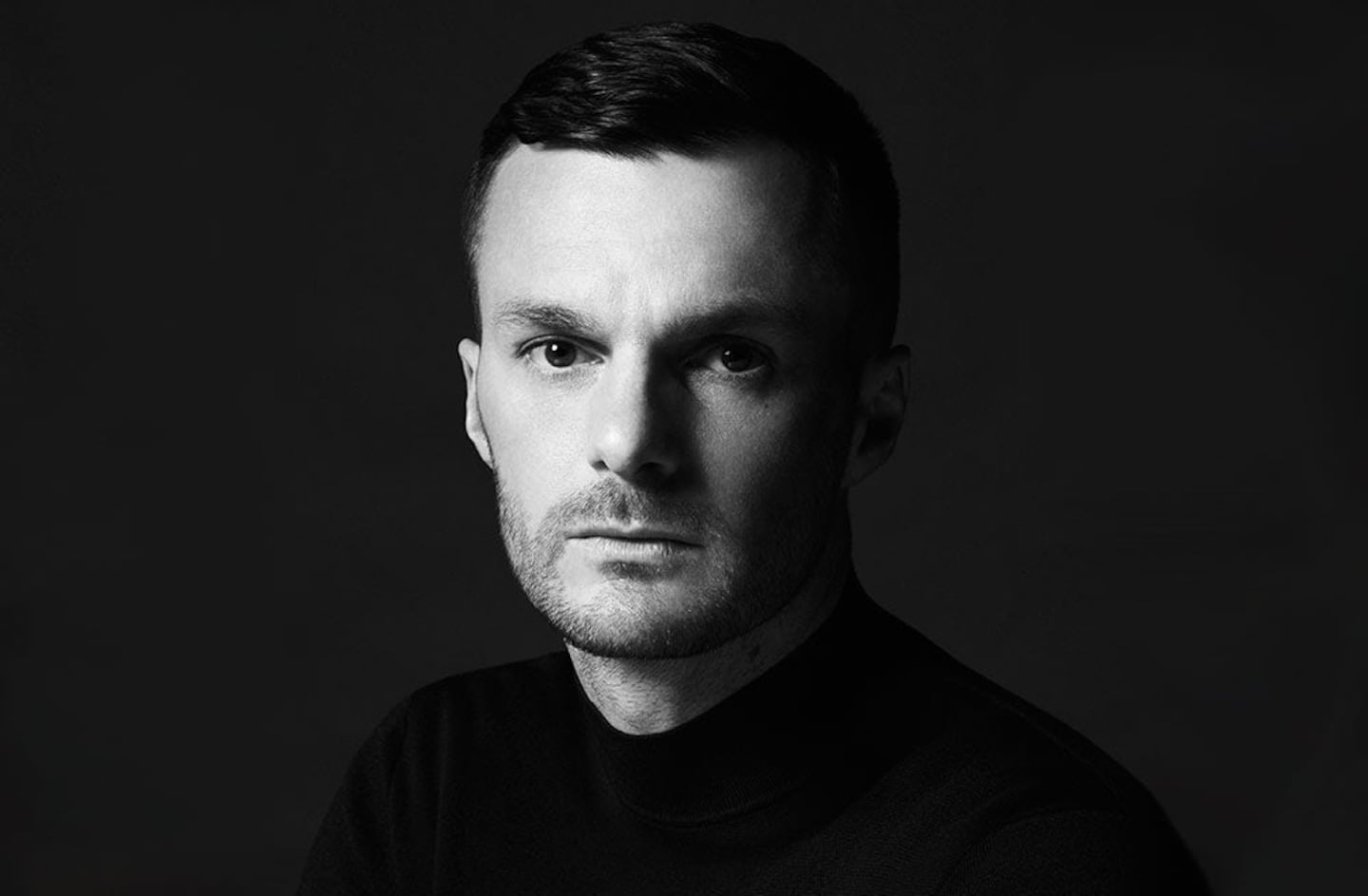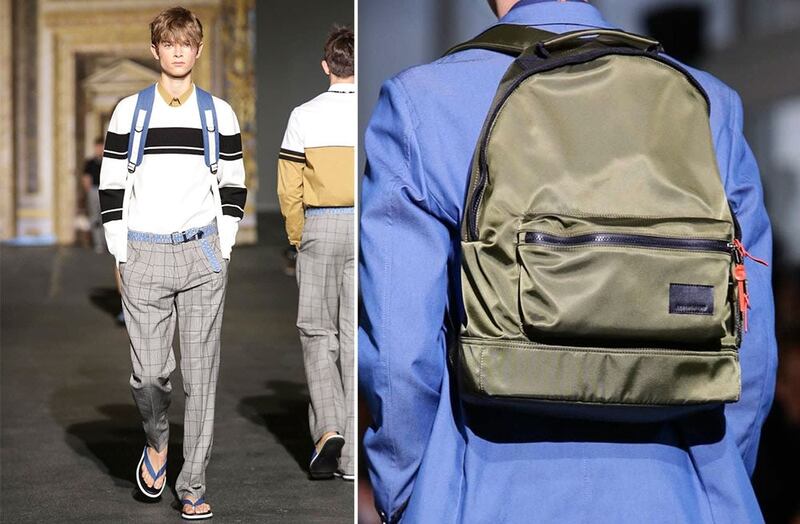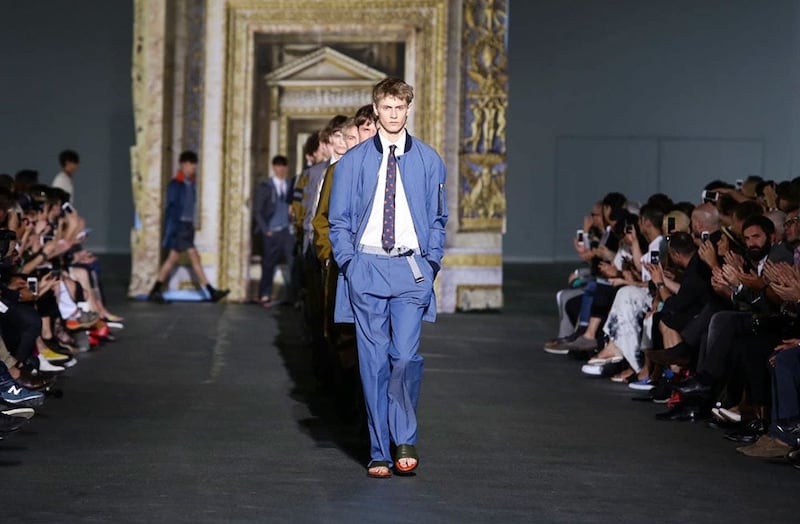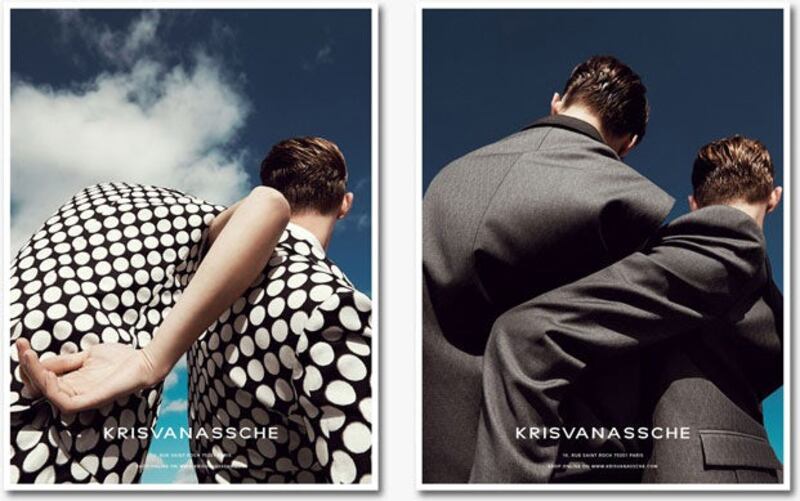
The Business of Fashion
Agenda-setting intelligence, analysis and advice for the global fashion community.

Agenda-setting intelligence, analysis and advice for the global fashion community.

PARIS, France — "Every season is more exciting, because I feel the expression is becoming more and more clear. And as I grow older, I keep learning, so at 20 collections, there have been a lot of small learning processes that add up and allow me to fine-tune things more each time." So says Kris van Assche, explaining the iterative advancement of his creative vision, a precise and determined personal quest that has kept the Belgian-born designer in the highest ranks of Paris menswear since he arrived in the French capital 16 years ago.
Leaving a rather comfortable situation being an assistant in a big house to launch my own company was the scariest, biggest thing I've done so far.
Two days ago, Van Assche presented a mix-and-match, denim-themed collection that included colour-blocked tops, superimposed jackets in various lengths and covetable backpacks with white piping — another study in the blend of sportswear and suiting that has become the calling card of Van Assche's label. Regarding the landmark show, his twentieth, Van Assche said: "It's another step forward within my vision of the Kris Van Assche man, which continues to evolve. And it's fun visually, because at this point in my career, I need a little lightness and fun." Indeed, the colour palette of Friday's show evinced a desire to defy the norm.

KRISVANASSCHE men's S/S 2015 | Source: Nowfashion.com
One can't blame the 38-year-old for feeling the need to let loose a little. The show was, in more than one way, a milestone for Van Assche, and the culmination of a decade-and-a-half of hard work. This year marks the tenth anniversary of his namesake label, which pioneered the finely calibrated mix of tailoring and casual elements that is so common now on both runways and in real life. Yet, if the idea of pairing a dinner jacket with sneakers seems commonplace today, Van Assche's designs stand out for their single-minded stringency and, in recent seasons, for the designer's increasing willingness to experiment.
ADVERTISEMENT
The show also capped off a busy year that signals a new phase of confidence and growth for Van Assche’s brand. In June 2013, the designer’s first standalone boutique opened on Paris’ Rue Saint-Roch, just around the corner from Rue du Faubourg Saint-Honoré, one of the city’s most exclusive shopping strips. The store opening was followed by a global e-commerce launch. And, most recently, Van Assche’s company moved into a large and airy space on a bustling street near Place de la République — in many ways the heart of Paris’ gentrified, but much less bourgeois east end — physically anchoring the brand and lending it a distinct off-centre character.
Van Assche grew up an only child in one of Belgium’s Flemish provinces, in a small municipality best known for its brewery and third-division football team. He says that while his family wasn’t artistic, he knew at a very early age that he would have to find a line of work that afforded him a “degree of self-expression,” specifically through clothes. “Even as a child, I would question the clothes my mother picked for me, why it was in my closet and where it came from. When I learnt someone had made that jumper or those trousers, I said ‘That’s what I want to do.’"
Van Assche was only eighteen when he enrolled at Antwerp's prestigious Royal Academy of Fine Arts. "It all started with that," he reflects. While he speaks highly of his famous alma mater, it was two unplanned moves after his graduation, in 1998, that paved the way for Van Assche's rise: "I came to Paris — which I hated — and I started working in menswear, which I had never touched." (At the Academy, Van Assche had studied womenswear). The driver of these unforeseen choices? An opportunity that would have been hard for anyone to turn down: a four-month internship at Yves Saint Laurent. "I thought it would give me the time to look for a real job."
Of course, the story unfolded differently, as this was no ordinary internship. At Saint Laurent, Van Assche assisted Hedi Slimane, who, although not quite the star he is today, was already beginning to attract attention and praise for his work channelling the codes of the house into commercially viable, sharply cut clothes for men. Four months turned into six years, as Van Assche followed his famous mentor when Slimane left Saint Laurent to head menswear at Dior in 2000. Albeit behind the scenes, Van Assche helped shape the remarkable four years that followed, when Slimane's collections for Dior Homme became the unofficial bellwether of men's fashion, their super-slim silhouette defining how young men around the world would dressed for the next decade.
Yet, Van Assche’s aesthetic sensibility is markedly different from that of his former boss, and the designer says his main learnings from his early stints at Yves Saint Laurent and Dior Homme were more practical that creative. “I got to see how a collection is constructed from day one and all the departments around it, like publicity, marketing, et cetera, things I hadn’t really been confronted with at the Academy, even though it’s a very good school. Assisting Hedi with the launch of Dior Homme was definitely something important for me, because that is when I realised things such as buttons don’t just fall from the sky onto a jacket. You have to make them, and if you want a logo on them, then you have to make buttons with a logo on them.”
The designer says his years assisting Slimane were “a six-year reality check.” He also discovered that “it’s not enough to be good designer; you need to be surrounded by a really good team. Because there’s only so much you can do yourself and everybody needs to do what they are good at. That was the biggest lesson for me.” It was priceless preparation for the big step that Van Assche would take next.
As the designer tells it, none of his early achievements compare to the giant leap he took in 2004. "Leaving a rather comfortable situation being an assistant in a big house to launch my own company was the scariest, biggest thing I’ve done so far. At 28, I was paying rent, and I had a comfortable salary, so it was definitely a gamble to drop all that and start my own company.”
Van Assche is candid about the personal dissatisfaction that lead him to start his own brand. "I had been frustrated and looking for a way out for a long time, at least a couple of years before I left Dior. It’s not that it wasn’t a great position, but I was assisting someone else’s dream and I felt I had reached a point where I had to tell my own story. I hadn't completed the Academy — which was incredibly tough — to be an assistant all my life. The whole time I was assisting, I could not forget how rewarding it had felt when I put on my final degree show [at the Academy] and I was desperate to go back to that feeling. It was really about me putting a fashion statement, a silhouette out there.”
ADVERTISEMENT

KRISVANASSCHE men's S/S 2015 | Source: Nowfashion.com
The support he needed to establish his own company came through friends and persistence. "I had been driving all my friends crazy complaining and one of them knew someone who knew someone else, which eventually brought me in contact with these people who financed young companies, even though they had never invested in a luxury or fashion business. They are still my partners today,” he said, declining to reveal their identities. “I presented them with this concept which was very rich in terms of fashion statements, but had little in terms of figures."
Van Assche needed a business plan, something he resisted at first. "It's not that I didn't care about the business side, but at Yves Saint Laurent and Dior, I had learnt that everyone should be doing what they're best at. And I knew that coming up with a business plan wasn't my forte."
Rescue, again, came through friends and Van Assche’s willingness to ask for help. "I ended up working on a business plan with people I had never met before, but who I was introduced to through friends that were tired of hearing me talk about my struggles. One of them was a banker. I would explain to them how I saw things and they helped me put it into realistic terms.” German-born designer Dirk Schonberger was also among Van Assche’s syndicate of consiglieri. “‘You need to have this type of a budget for fabrics, this for models, et cetera,’ Dirk told me — he gave me a few invaluable clues.”
“My first reaction was, ‘I don't know how to do a business plan, I am not going to do it. You're the business people, you take care of it, I'll make the clothes.’ But they said 'No, you want your company, you come up with a business plan.’ It was one of the best things that ever happened to me, because it made me take responsibility and learn.”
"I had an office on the first of November [2004] and I remember plugging in the fax machine, because back then we sent faxes to order fabric. I was so desperate to have a fax number. My show was at the end of January," recalled Van Assche. "It was a nightmare, there were just three of us doing everything." Nonetheless, Van Assche's label got the attention of the industry right from its inception — Suzy Menkes attended the designer's first show.
Ten years later, Van Assche says the challenges of running an independent label remain the same. "Doing good shows and good collections isn't enough. It's the whole package around it: You also have to have the right commercial person, the right press person, the right strategic vision, a good accountant, and so on. It’s as essential as what you show on the runway, and in some ways, the trickiest part."
Then, there's what Van Assche calls fashion's number one rule: "The more you sell, the more you are in trouble." Van Assche thought after his first show he would have around 15 clients. Instead, 45 retailers placed orders. "That sounds great but it also means you have to make the stuff, buy the fabrics and finance the production. Then you send the clothes in June but people don't start paying until July and we just didn't have enough cash for all that. The bigger you become, the more money you need."
ADVERTISEMENT
When, in 2007, following Slimane’s departure from Dior Homme, Van Assche was offered and accepted the top creative post at the house where he had previously worked, he admits it affected his own brand. "My appointment [at Dior] definitely took things to the next level. I was only in my fifth show with my own label but, all at once, it got a lot more attention.”
While Van Assche says sales have been growing consistently for the last few years — he declined to reveal exact revenue or growth figures — he confesses that his brand has faced some challenges along the way, most noticeably during the financial crisis of 2008. "I am not sure that being a young label is supposed to be smooth and struggle-free. If it's easy, it probably means you are not being ambitious enough," he said, adding: "You need to constantly adapt yourself, like when the financial crisis hit the world. Stores bought less and safer, more well-known brands. We felt that. If you are a small label, you feel the tiniest breeze." On the flipside, "the advantage of being an independent young label is that you can actually make decisions quite fast and you can change your mind without too many consequences," said Van Assche.
Today, Van Assche’s label is available in 150 stores in 31 countries. "Historically, from day one, Japan was our biggest market, followed by Europe. Now the Chinese market is becoming more important, as is the American market, though the United States is tough for an independent label because you need a lot of communication and resources there that we don't have as a still relatively small, young company."
The menswear boom of recent years means the market "has become as diverse and important as womenswear, with the big difference than it some ways it's tougher, because you can't have an 'it bag' or 'it shoes,' which is where a lot of brands make their money," said the designer. That's not to say Van Assche doesn't have some 'it' items of his own. The business performs well with shirts and knits. Shoes are also strong, in particular the 'multi-lace' high-top sneaker that comes in black and white every season, along with one-off variations (like crocodile-embossed for Spring-Summer 2014). The shoe, which retails for around €500, is known to be a favourite of members of the French football team. Bags have also become a lucrative category for Van Assche, not least thanks to a two-year collaboration with Eastpak which he calls a "tremendous success." "After four successful seasons we decided to halt the collaboration, but in the meantime we had learnt how to make bags and we had grown a customer for our bags." (Van Assche has refused a number of other collaborations. "I think it should bring me something that I don't know how to do myself and vice versa. You don't make a lot of money with these collaborations, so you have to do it for other reasons," he said.)
Van Assche doesn't like to look back. Yet he gets excited when talking about the collection currently in stores (Spring-Summer 2014), calling it a turning point. "It marks a moment when I decided to go full on fashion. I think it's good thing for the brand. It became more fashion, more visual and more fun for me to work on." But the designer admits that the move has alienated some of his early stockists. "We use to hang with established big labels; we were the cool brand next to them. We were considered ‘classic with a twist,' as much as I hate that phrase. Now the stores that buy us are much more fashion-oriented. We have become too loud for certain stores."

KRISVANASSCHE S/S 2014 campaign | Source: KRISVANASSCHE
How does Van Assche balance his responsibilities at Dior Homme with his role at his own label, and how does he maintain a separate aesthetic approach for each brand?
"I have been doing this for seven years (working between Dior and his own label). Creatively, I have grown an intuition to know which idea goes best with each label. Logistically, it's very helpful that both brands are in Paris." He normally spends around two days a week at Kris Van Assche and three days a week at Dior. "Obviously there's times when I don't know where I am, but overall it works really well. Only when I am choosing fabrics and colour cards, that's always a nightmare."
What makes it work, he added, is that he is surrounded by the right people. Today, the designer has 12 full-time employees working at his own brand. "The best people I have are interns that grew into their job. Maybe they started doing something totally different, but turned out to have a real talent for something else. You could be working in the commercial department one day and end up working in the studio the next day, and my first assistant never went to fashion school — that’s not a problem for me. If you have passion and do what you do well, that’s all that matters to me. They also move between the two brands. The few times I've had the ambition to go outside of the brand and hired someone with more experience, it didn't yield the happiest choices."
Van Assche says it’s a common misconception for people to think that his own label allows him a lot more freedom than working for a big house. He disagrees, saying that with the same freedom comes a lot of responsibility. "Yes, it’s a lot of fun, but a lot of struggling as well. At Kris Van Assche, we cannot afford to have a bad season,” adding: "The amount of visibility that I've had through Dior is huge, it’s impossible to deny that. But there has been no financial, strategic or professional support directly from the house. But as a designer I've learnt so much [working for Dior] and whatever I learn is passed on to my label, so it’s definitely benefitted my brand."
Where does Van Assche see his business at this major milestone?
"A decade is a decade. I am working on getting to the next level. But it's too early to talk about it. It’s about growing for the next five to ten years, finally breaking into the United States and gaining ground in China, which is a huge challenge. But for that I need to adapt my resources to face today’s economic realities. If you see how much big brands — which are already well-known — are spending on communication worldwide, how much effort and money they invest, just imagine me being an independent, fairly unknown name. I need to make at least a little noise in order to survive."
"So I am trying to find the tools to make noise."
Discover the most exciting career opportunities now available on BoF Careers — including jobs from Gucci, Simone Rocha and Bloomingdale’s.
BoF spoke to HR executives and talent experts at Alexander McQueen, On and Deckers Brands — global employers currently recruiting on BoF Careers — to understand what skills are most relevant to the fashion industry and how to upskill in them in the workplace.
The nature of working in retail is changing at pace as the purpose of stores continues to evolve. BoF Careers examines how in-store employees can hone and develop their skill sets for success in retail or its adjacent industries, sharing expertise from retail leaders and fashion executives who began their careers on the shop floor.
A tailored recruitment service offering specialist support to secure top-tier talent for your open roles — from entry-level to C-suite positions across fashion, retail, luxury and beauty.